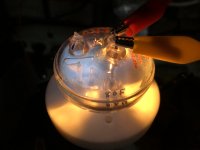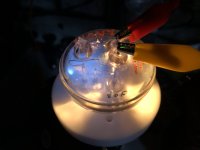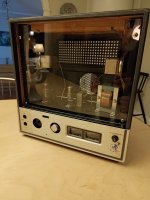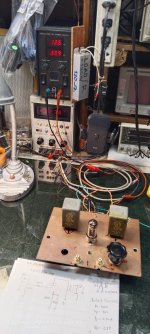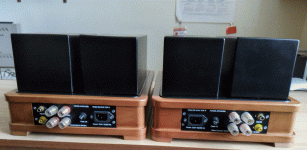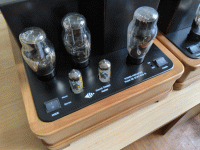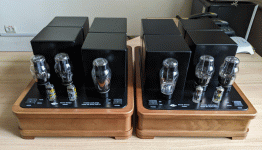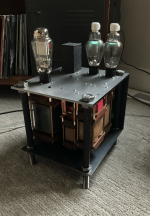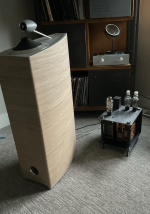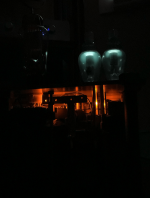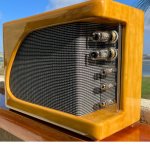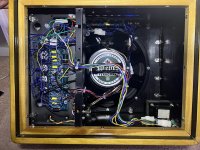I have an unreasonable fascination with volume controls. Are you able to articulate the difference in sound the AVC gives you as opposed to a stepped attenuator or high quality pot? Does the circuit need to be noticeably different to use an AVC or are you able to switch out different kinds of attenuators easily?
If you're still in play mode, it's worth considering returning C5 to the cathode of U4. With a transformer coupled driver circuit fed by a constant current source the dynamic currents of C5 and U4 will then sum at R5 again to a constant current, removing the need for C1. The value of C5 may require optimizing against L1 in measurements and Spice. The CCS deals with any power supply noise.
@isaacc7 in my recent AB tests, the AVC has a more full sound, a slightly larger stage, and more natural. The conventional pot is thinner by comparison. The AVC performs I/V conversion whereas a conventional pot shunts the excess signal to ground. The circuits do not need to be different, in fact you could put a AVC in front of an existing potentiometer and just turn it to maximum volume. Dave recommends putting the AVC in a separate chassis from other transformers.
@rdf thanks for the idea, I'll take a look at that in LTSpice. The value of C5 is somewhat fixed however, those are the large blue film caps protruding out of the top of the chassis, but I could place another bypass cap in parallel. I'll be making some changes tomorrow to try and tame the D3a, once that is sorted and if LTSpice checks out, I'll give your idea a try as well.
The Onkyo sees very little action these days 😀

Members can start a new thread and use the paging system ( @Jbhunter1 ) to call for the attention of any member.I’m currently under moderation on this forum but could you message me so I can ask you a few questions about the parts for this build?
Decided to apply some power to a pair of 368A tubes that had been sitting on my display shelf for years. Long ago I had always toyed with the idea of using them to drive a larger tube and even had some sockets machined. The first tube lit but rather dimly, I recalled them being brighter but oh well. Let it burn in for a few minutes and then noticed it was out. High resistance now. Guess the vacuum was bad and the filament was slowly burning out. Ok onto the second tube. This one lights bright as it should so let's apply some plate voltage and grid bias. Hmmm 100 volts on the plate and no current draw. Crank up the voltage further and see a distinctive blue glow inside. This second tube is also a dud. Oh well enjoy the pictures. I discovered two 388A tubes that I don't even remember buying. These actually light as expected but have different dimensions on the pins so my old sockets will not work. Later on I'm going to wire up a Hammond SE transformer and feed my distortion analyzer right into the grid as it can output 16 volts. Should be an interesting experiment!
Attachments
astouffer,
I like your activity and work.
Sorry for the 368A duds. RIP.
Sometime I hope to build my 4-65A pair, and my 5894 pair, into SE mono-blocks.
I like your activity and work.
Sorry for the 368A duds. RIP.
Sometime I hope to build my 4-65A pair, and my 5894 pair, into SE mono-blocks.
I had two Hammond M3 organ power transformers that had been begging to be put into monoblocks for the last 6 years and if I finally got around to it. I built these around the power transformers and 6BG6 output tubes, with the design goal of having the amps occupy an 8.5”x11” letter sized footprint. Front end is a 6SN7 and rectifier is 54UG.

The chassis construction is all original, custom designed by me. Cut, formed, and anodized by SendCutSend.

The trim is painted MDF.

Close up of some of the cosmetic fasteners. Thrifted from my line of work:

The internals are point to point. I got quite deep into PCBs for a while, but decided to go back to basics for this one.

Thanks for looking!
The chassis construction is all original, custom designed by me. Cut, formed, and anodized by SendCutSend.
The trim is painted MDF.
Close up of some of the cosmetic fasteners. Thrifted from my line of work:
The internals are point to point. I got quite deep into PCBs for a while, but decided to go back to basics for this one.
Thanks for looking!
A front stage of an electronic tube was made using a millivolt meter case.









The schematic is very simple, even my mother can visualize it(by the way, my mother is an retired Tektronix designing engineer):
LTP input with 6n1p and 3mA CSS, DC coupled to differential driver with ecc82, auto-biased PP el12n.
Frequency response: 7Hz-200kHz 1w/8ohm
THD: 0.01% 1w/8ohm
Just an interim amplifier (had to dismantle my EL34-amp for rework). 5U4GB, 6F6, 6SL7, 6SN7 (all tubes old russian equivalents)



Hi Everyone, hope all is well. Here is my latest pair of monoblocks. An EML 30A spud. The beautiful 866A rectifiers are glowing blue which nicely contrasts with the LED bias that glows orange/yellow under the hood. They weigh about 80 lbs. each. And, most importantly, use Muse Coils Minotaur iron.
Attachments
SVStube, nice work there, especially impressed with the chassis, how did you print the lettering?
Banpuku, nice design, if a bit deadly, but forgive my ignorance where are the monoblocks? All I can see is a power supply and a speaker?
Waiting on parts, welcome to the forum, nice cabinet work, is it a guitar amp or mono hifi amp?
Andy.
Banpuku, nice design, if a bit deadly, but forgive my ignorance where are the monoblocks? All I can see is a power supply and a speaker?
Waiting on parts, welcome to the forum, nice cabinet work, is it a guitar amp or mono hifi amp?
Andy.
- Home
- Amplifiers
- Tubes / Valves
- Photo Gallery
